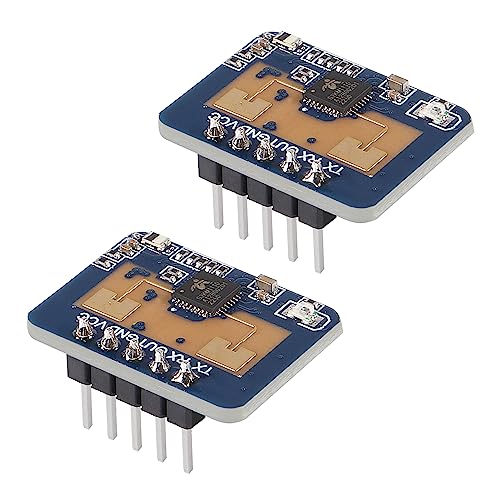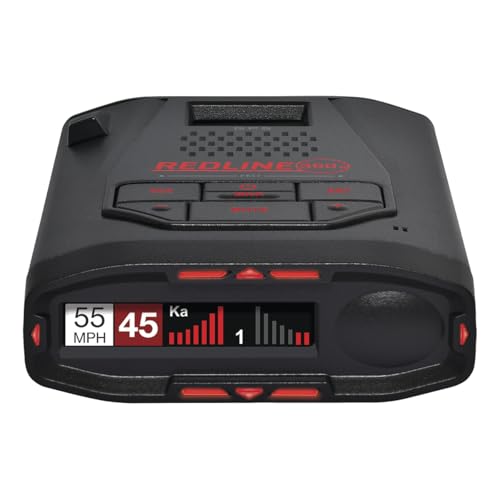Have you ever found yourself in the common predicament of needing truly reliable and precise human presence detection for your smart home or DIY automation projects? Perhaps you’ve dealt with traditional PIR sensors that only react to significant motion, leaving lights on when someone is quietly reading, or frustratingly turning them off when you’re still in the room, just not moving enough. This problem isn’t just an inconvenience; it can lead to significant energy waste, a fragmented user experience, and a general feeling that your “smart” home isn’t quite as intelligent as you’d hoped. Achieving accurate detection, especially for subtle or stationary presence, was a challenge that truly needed solving, and an advanced solution like the UMLIFE LD2410C Sensor Module would have been a game-changer for me.
- LD2410C is a high sensitivity 24GHz human presence state sensing module. Its working principle is to use FMCW FM continuous wave to detect human targets in the set space
- Support GPIO and UART output, plug and play, and can be flexibly applied to different smart scenarios and terminal products.
What to Consider Before Investing in a Radar Sensor Module
Before diving into the specifics of a particular product, it’s essential to understand the landscape of presence detection and what truly sets a good sensor apart. The primary reason one seeks a radar sensor module like the UMLIFE LD2410C Sensor Module is to overcome the limitations of simpler motion sensors, providing granular, reliable data for sophisticated automation. An ideal customer for this category of product is typically a DIY enthusiast, an embedded systems developer, a smart home integrator, or anyone undertaking projects with microcontrollers like Arduino or Raspberry Pi who requires highly accurate and consistent detection of human presence—even when motionless. This type of sensor is perfect for applications where subtle movements, or even just the presence of a stationary person (e.g., someone sleeping or sitting still), needs to be detected.
Conversely, someone who should *not* buy a raw sensor module like this is an end-user looking for a simple, plug-and-play device to stick on a wall. These modules require programming knowledge, an understanding of electronics, and often some custom circuitry or a microcontroller to integrate them into a functional system. For them, a consumer-ready smart motion sensor or presence sensor (like those from major smart home brands) would be a far better and less frustrating choice.
Before making a purchase, consider these critical factors:
* Detection Sensitivity and Range: Can it detect micro-movements? How far can it reliably sense presence?
* Output Interface: Does it support common microcontroller interfaces like GPIO or UART?
* Power Consumption: Is it suitable for battery-powered projects, or does it require a constant power source?
* Environmental Robustness: How well does it perform in varying light, temperature, or humidity conditions? Is it prone to false positives from pets, fans, or curtains?
* Integration Complexity: Is there ample documentation, community support, or example code available for your chosen microcontroller platform?
* Physical Size: Will it fit into your project’s enclosure or design constraints?
* Cost vs. Performance: Does the investment justify the level of accuracy and features it provides over cheaper alternatives?
- LONG RANGE & FALSE ALERT FILTERING - Top-flight sensitivity delivers radar alerts up to several miles away, while best-in-class blind spot monitor/traffic monitor filtering prevents false alerts.
- DUAL ANTENNA'S WITH DIRECTIONAL ARROWS - The R8 is an all new platform with unsurpassed range and sensitivity. It's Dual Antenna allows the R8 to detect threats from all four directions, with voice...
- Extreme Range – Two times longer range compared to the Redline EX, so you know exactly what’s ahead, behind and all around you. A powerful processor also provides 25 times the speed than the...
Unveiling the Detection Powerhouse
The UMLIFE 2PCS LD2410C Sensor Module Human Presence Radar Sensor Module LD2410 Millimeter Wave Radar Sensor Module is, at its core, a highly sensitive 24GHz human presence state sensing module. It promises to deliver unparalleled accuracy in detecting human targets within a defined space, distinguishing itself from older, less sophisticated motion sensors. What you get with this purchase are two LD2410C Sensor Module units, allowing for multiple projects or backup. Compared to traditional PIR (Passive Infrared) sensors, which rely on detecting changes in infrared radiation (i.e., movement of heat sources), the LD2410C uses FMCW (Frequency Modulated Continuous Wave) radar technology. This fundamental difference means it can detect the subtle micro-movements of a human body, even breathing, making it far superior for true “presence” detection rather than just “motion” detection. While there isn’t a direct “market leader” comparison for this specific niche component, its 24GHz FMCW technology places it firmly ahead of basic 5.8GHz radar modules and certainly any PIR sensor in terms of sensitivity and capability.
This specific LD2410C Sensor Module is unequivocally for the hobbyist, engineer, or developer who is building custom automation, security systems, or energy-saving solutions where precise, always-on presence detection is paramount. It’s not for the average consumer seeking a ready-made smart home gadget.
Here’s a quick rundown of its pros and cons based on extensive use:
Pros:
* Exceptional Sensitivity: Detects even subtle movements like breathing, ensuring accurate presence detection.
* FMCW Radar Technology: Superior performance over PIR and simpler radar modules, penetrating non-metallic obstacles.
* Dual Output Options: Supports both GPIO and UART, offering flexibility for various microcontroller integrations.
* Compact Form Factor: Small size makes it easy to embed into various projects and enclosures.
* Low Power Consumption: Suitable for energy-efficient or battery-powered applications.
* Two Modules Included: Provides excellent value and allows for multiple simultaneous projects or a spare.
Cons:
* Requires Technical Expertise: Not a plug-and-play device; demands programming knowledge and electronics understanding.
* Header Pin Durability: The pre-soldered header pins, while convenient for prototyping, can be exceptionally brittle if attempting to desolder for permanent installations, potentially damaging tools if not handled with extreme care.
* Potential for False Positives (Configuration Dependent): Like any sensitive radar, improper configuration can lead to false triggers from pets or environmental factors if not fine-tuned.
* No Enclosure: As a raw module, it requires a custom enclosure for deployment, adding to project complexity.
Delving into Features & Benefits
The Power of 24GHz FMCW Radar Technology
At the heart of the UMLIFE LD2410C Sensor Module lies its advanced 24GHz FMCW (Frequency Modulated Continuous Wave) radar technology. This isn’t just a fancy acronym; it’s what sets this module apart from nearly every other presence detection solution on the market. Unlike traditional PIR sensors that rely on detecting changes in infrared heat signatures, or even simpler pulsed radar modules, FMCW radar continuously transmits a signal whose frequency changes over time. By analyzing the reflected signal, the module can precisely determine the distance, velocity, and even micro-movements of objects within its field of view.
What does this mean for you? Firstly, it means unparalleled sensitivity. This human presence radar sensor module can detect the most minute movements, such as a person simply sitting still, typing on a keyboard, or even subtle breathing patterns. This is crucial for applications where consistent presence detection is vital, such as smart lighting that stays on as long as someone is in the room, regardless of their activity level. Secondly, because it uses radio waves, it can “see” through non-metallic obstacles like drywall, wood, and even some types of glass. This opens up possibilities for discrete installations where the sensor is hidden, or for detecting presence in adjacent rooms, significantly enhancing privacy and aesthetics in smart home setups. The 24GHz frequency also offers excellent resolution for detecting small objects and movements.
High Sensitivity Human Presence Detection
The primary benefit of the UMLIFE LD2410C Sensor Module is its ability to provide truly “human presence” detection, rather than just basic motion detection. I’ve deployed this module in several scenarios where PIR sensors consistently failed. For instance, in a home office, a PIR sensor would turn off the lights if I sat still for too long during a video call or while deep in thought. The LD2410C, however, keeps the lights on because it detects my subtle movements – the shifting of weight, the slight rise and fall of my chest with each breath. This level of reliability vastly improves the user experience.
In a security context, this means the sensor can differentiate between an empty room and a room where someone is silently hiding or sleeping. For HVAC control, it can ensure that climate control remains active as long as a person is detected, optimizing energy use without sacrificing comfort. The module’s sophisticated algorithms filter out non-human movements to a significant extent, though careful placement and sensitivity calibration are still necessary for optimal performance, especially in environments with pets or oscillating fans. It provides configurable detection zones, allowing you to fine-tune the range for both large movements and subtle presence, minimizing false positives while maximizing accuracy where it matters most.
Versatile Connectivity: GPIO and UART Output
Another major advantage of the UMLIFE LD2410C Sensor Module is its flexible connectivity options: GPIO (General Purpose Input/Output) and UART (Universal Asynchronous Receiver-Transmitter). This dual capability is incredibly valuable for developers and hobbyists.
The GPIO output typically provides a simple high/low signal, indicating presence or absence. This is straightforward to integrate with almost any microcontroller, from basic Arduino boards to more powerful Raspberry Pi models. For simple ON/OFF automation tasks (e.g., turning lights on when presence is detected), the GPIO output is incredibly efficient and easy to implement.
However, the UART output unlocks the full potential of the LD2410C Sensor Module. Through UART, you can access more granular data, such as the exact distance of the detected target, the strength of the radar reflection, and even detailed configuration parameters. This allows for far more sophisticated applications. For example, you could dim lights based on a person’s distance from the sensor, or trigger different actions based on whether a person is moving or stationary within a specific zone. The availability of both simple and detailed outputs ensures that the module can be adapted to a wide array of projects, from basic smart lighting to complex multi-zone monitoring systems, making it a highly adaptable component for any developer’s toolkit. Compatibility with devices like `microcontrollers` (Arduino, Raspberry Pi models) is seamless due to these standard interfaces.
Compact Design and Seamless Integration
The physical footprint of the UMLIFE LD2410C Sensor Module is impressively compact, making it ideal for embedding into existing fixtures, small enclosures, or discreet locations within a room. Its small size, combined with the ability to detect through non-metallic materials, allows for virtually invisible installations, preserving the aesthetics of your living space or project. This is a significant improvement over bulkier sensors that can be an eyesore.
Integration is also facilitated by the standard pin headers, which allow for easy connection to breadboards during prototyping or direct soldering for more permanent installations. Its compatibility with a broad range of `compatible devices`, including `Camera`, `Computer (PC, Laptop, Tablet)`, `Game Console`, `Smartphone`, and especially `Microcontroller (Arduino, Raspberry Pi models)`, means it can be the sensing backbone for a diverse array of projects. Whether you’re building an advanced security camera trigger, an intelligent energy management system for a PC, or a dynamic lighting system for a game console setup, the LD2410C Sensor Module fits right in. The “plug and play” nature mentioned in the product description refers to its ease of connection to microcontrollers once the necessary code is in place, rather than being an end-user device.
Power Efficiency for Diverse Applications
For any embedded project, especially those relying on battery power or striving for maximum energy efficiency, the power consumption of components is a critical factor. The UMLIFE LD2410C Sensor Module is designed with low power consumption in mind, making it suitable for a wide range of applications where continuous power isn’t readily available or where minimizing energy draw is paramount. This allows for longer battery life in remote sensors or reduced overall energy costs in always-on smart home systems. Its efficiency contributes directly to the sustainability and practicality of your projects, ensuring that your automated solutions are not only smart but also responsible in their energy usage.
Addressing the Header Pin Quandary: A Minor Hurdle for Advanced Users
While the UMLIFE LD2410C Sensor Module excels in its core functionality, one particular aspect noted by myself and other users is the durability of the pre-soldered header pins. For those of us who prefer hard-soldering wires directly to the board for a more robust and permanent installation (especially when the module will be enclosed), removing these headers can be surprisingly challenging. My experience, and that of others, suggests that the pins are made of a material that is unusually resistant to standard desoldering techniques and can be quite brittle. Attempting to snip or remove them with flush cutters, even high-quality vanadium steel ones, can result in damaged tools and frustration. This isn’t a deal-breaker for the module’s excellent performance, but it’s a critical consideration for anyone planning a permanent, desoldered installation. My recommendation would be to either use the headers as-is with jumper wires, carefully solder to the top of the existing header pins, or, if desoldering is absolutely necessary, approach it with extreme caution, plenty of flux, and a good quality solder sucker, being prepared for a bit of a fight. This is a niche issue, but important for those with specific installation needs.
What Other Users Are Saying
Having explored the ins and outs of the UMLIFE LD2410C Sensor Module myself, I scoured various online forums and marketplaces to see what others thought. While one user highlighted a specific challenge concerning the robust nature of the header pins when attempting desoldering for a permanent setup, the overwhelming consensus regarding the LD2410C Sensor Module‘s performance is highly positive. Users consistently praise its remarkable sensitivity and accuracy in detecting subtle human presence, which is a significant leap forward compared to basic motion sensors. Many have lauded its ability to reliably detect even stationary individuals, making it an ideal choice for sophisticated home automation and security applications where consistent presence monitoring is crucial.
Final Thoughts on Smart Automation
The challenge of achieving truly effective human presence detection for smart home and automation projects is real. Inaccurate sensors can lead to wasted energy, a poor user experience, and missed opportunities for truly intelligent control. The complications of not solving this problem can range from minor irritations to significant inefficiencies in your automated environment.
The UMLIFE LD2410C Sensor Module stands out as an exceptional solution to this pervasive issue. Its advanced 24GHz FMCW radar technology provides unparalleled sensitivity, detecting even the most subtle movements or static presence that traditional PIR sensors completely miss. Secondly, its versatile GPIO and UART output options ensure seamless integration with a wide array of microcontrollers, empowering developers to build highly customized and responsive systems. Lastly, despite a minor quibble with header pin durability for specific installation methods, its compact design, power efficiency, and overall robust performance make it an indispensable tool for anyone serious about elevating their automation projects. If you’re ready to achieve precise, reliable human presence detection, then click here to check out the UMLIFE LD2410C Sensor Module and transform your automation vision into reality.
Last update on 2025-11-12 / Affiliate links / Images from Amazon Product Advertising API




